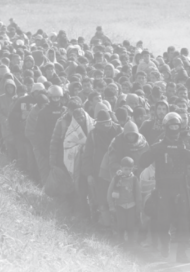Posted on 25 May 2016
In a research collaboration between the Global Initiative and RMMS (the Regional Mixed Migration Secretariat), Head of the Secretariat Tuesday Reitano co-authored a report, “A perfect storm? The factors shaping modern migration” that identifies the different aspects of globalisation and governance through the lenses of economy, culture, demography, communications, crime and security, that collectively have contributed to a new era in mixed migration, refugee movements and displacement.
In a view of the unusually high number of refugees and IDPs globally and the high number of migrants on the move, many of which are using smugglers to enter countries irregularly, we have arguably entered a new era in mixed migration, refugee movements and displacement.
The issue of migration and refugees has become a central political concern in many countries. If left unaddressed or if poorly addressed, the political and social consequences will be significant. It is, therefore, critical to acknowledge both the new challenge and the new context that this phenomenon represents and ask if the volume and the manner of movement that we are currently witnessing is a temporary phenomenon or whether it is instead the “new normal”?
This paper identifies a range of contextual forced and factors that when combined have every chance of creating a major migration and displacement nexus:
- A world of disparity: Structural realities of global poverty, democraphy and development in the contemporary world are challenging existing frameworks and commonly understood norms of trade and development, and are creating a pressure to migrate in the Global South that cannot be underestimated.
- Global vectors: Decades of irregular labour mobility have enabled a new dynamic of aspirations and chain migration that should be understood now as systemic rather than localised. An infrastructure of Diaspora network, remittance payments and improved communication technology enable and reinforce this cycle. In addition, a set of global vectors are exacerbating the irregular migration trends, both amplifying the scale of the flow and increasing the vulnerability of migrants in the process.
- Riding the storm: One of the gratest challenges in responding to the new landscape for migration is a set of deeply entrenched existing policy paradigms and the constraints of the multilateral system to address such a sprawling and rapidly evolving phenomenon.
The paper identifies the critical role played by smugglers in the new migration paradigm. While the human smuggling industry is not new, within the framework of new global mobility and in the absence of safe and legal options for migration, it has become a vector in the movement of migrants and refugees. A highly responsive market force, human smugglers have proved themselves to be resilient and innovative, both amplifying the scale of the flow and shaping its manifestations, whilst demonstrating an ability to form collaborative networks that span astonishingly large distances. Whereas traditionally this has been a low priority crime – a collateral activity that swelled the profits on an ad hoc basis on the back of other forms of illicit trade, human smuggling is quickly becoming one of the most lucrative forms of transnational crime, with grave consequences for for the safety and security of migrants themselves as well as for states in which they recruit, transit and deposit migrants.
States are now examining how to respond to the growth in human smugglers more than ever. Not least as they are increasingly demonized as the reason for rising irregular migration. The policy rhetoric around responses to human smuggling is increasingly mirroring that of the Drug Wars of the 1980s, with promises of “crackdowns” on smuggling, “breaking the business model”, the deployment of warships, militaries and the full range of law enforcement instruments. This response is insufficiently nuanced. In the contemporary setting, the smuggling industry is a multi-faceted and diverse enterprise that encompasses everything from opportunist individuals, to local criminal gangs, to labour migration agencies, and in some cases a limited number of highly structured criminal organizations. One policy prescription is unlikely to cater to all manifestations of the smuggling industry, and the ‘hard security’ and border control focused responses have caused smuggling service providers to become more organized and more violent.
Furthermore, given the paucity of safe and legal options available for those migrating even from conflict zones, smugglers are often perceived as saviours by those they transport, and thus command considerable loyalty and legitimacy within the populations that they serve. In some cases, smuggling networks have been closely linked to militia groups, criminal gangs or terrorist groups who are engaged in exercises of competitive state-making and conflict, which in turn complicates the ability of the state to engage and reinforce the rule of law. Given the complexity of the environment, straightforward justice and security led strategies using traditional law enforcement instruments have struggled to gain traction and demonstrate tangible results.
The paper concludes that, ultimately, there is a lack of political responses and current migration policies that fail to offer any sustainable response to the situations that are producing migrants and refugees. Similarly, the policy debate within the multilateral framework is providing little in terms of constructive solutions that recognis and respond to an environment that has fundamentally and permanently changed. It is, therefore, urgently time to shift to a new paradigm which requires unpicking some longstanding assumptions, changing attitudes and developing policies.




